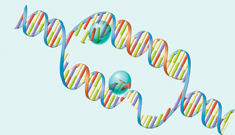12.3 DNA Replication
Understand Key Concepts
In prokaryotes, DNA molecules are located in the
nucleus.
ribosomes.
cytoplasm.
histones.
In eukaryotes, nearly all the DNA is found in the
nucleus.
ribosomes.
cytoplasm.
histones.
The diagram below shows the process of DNA
replication.
digestion.
transformation.
transpiration.

The main enzyme involved in linking individual nucleotides into DNA molecules is
DNA protease.
ribose.
carbohydrase.
DNA polymerase.
What is meant by the term base pairing? How is base pairing involved in DNA replication?
Describe the appearance of DNA in a typical prokaryotic cell.
Explain the process of replication. When a DNA molecule is replicated, how do the new molecules compare to the original molecule?
Think Critically
Use Analogies Is photocopying a document similar to DNA replication? Think of the original materials, the copying process, and the final products. Explain how the two processes are alike. Identify major differences.
Compare and Contrast Describe the similarities and differences between DNA replication in prokaryotic cells and in eukaryotic cells.
Predict Use your understanding of the structure of DNA to predict what sorts of problems excessive UV light might produce in the DNA molecule. How might these changes affect the functions of DNA?
Infer All cells have systems of enzymes that repair UV-induced damage to their DNA. Some cellular systems block DNA replication if there are base pairing problems in the double helix. Why are these systems important? How might they work?
Relate Cause and Effect Analyze the effects that UV light might have on skin cells. Why is UV light so dangerous? Why is the skin particularly vulnerable to it?
Connect to the
 Among humans who inherit genetic defects in their DNA-repair systems, the incidence of skin cancer is as much as 1000 times greater than average. Based on this information, what can you infer about the effect of UV light on DNA?
Among humans who inherit genetic defects in their DNA-repair systems, the incidence of skin cancer is as much as 1000 times greater than average. Based on this information, what can you infer about the effect of UV light on DNA?

solve the CHAPTER MYSTERY

UV LIGHT
The nucleotides in DNA include the nitrogenous bases adenine, cytosine, guanine, and thymine (A, C, G, and T). The energy from UV light can produce chemical changes in these bases, damaging the DNA molecule and producing errors when DNA is replicated.
Table of Contents
- Formulas and Equations
- Applying Formulas and Equations
- Mean, Median, and Mode
- Estimation
- Using Measurements in Calculations
- Effects of Measurement Errors
- Accuracy
- Precision
- Comparing Accuracy and Precision
- Significant Figures
- Calculating With Significant Figures
- Scientific Notation
- Calculating With Scientific Notation
- Dimensional Analysis
- Applying Dimensional Analysis




